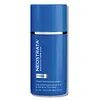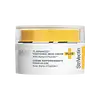What's inside
What's inside
 Key Ingredients
Key Ingredients

 Benefits
Benefits

 Concerns
Concerns

 Ingredients Side-by-side
Ingredients Side-by-side

Water
Skin ConditioningAcetyl Glucosamine
Skin ConditioningCyclopentasiloxane
EmollientTriethyl Citrate
MaskingCetearyl Alcohol
EmollientC12-15 Alkyl Benzoate
AntimicrobialButyrospermum Parkii Butter
Skin ConditioningGlyceryl Stearate
EmollientCyclohexasiloxane
EmollientGlycerin
HumectantIsocetyl Stearoyl Stearate
EmollientDimethicone
EmollientEthoxydiglycol
HumectantPEG-100 Stearate
Polymethylsilsesquioxane
Nylon-12
Isostearic Acid
CleansingTocopheryl Acetate
AntioxidantPalmitoyl Glycine
CleansingMalus Domestica Fruit Cell Culture Extract
Skin ConditioningHydrogenated Palm Kernel Glycerides
EmollientHydrogenated Palm Glycerides
EmollientDimethiconol
EmollientIsopropyl Myristate
EmollientCaprylyl Glycol
EmollientLecithin
EmollientPEG-40 Stearate
EmulsifyingCeteareth-20
CleansingCarbomer
Emulsion StabilisingXanthan Gum
EmulsifyingPentaerythrityl Tetra-Di-T-Butyl Hydroxyhydrocinnamate
AntioxidantSodium Bisulfite
AntioxidantDisodium EDTA
Ammonium Hydroxide
BufferingChlorphenesin
AntimicrobialPhenoxyethanol
PreservativeEthylene Brassylate
MaskingMethyldihydrojasmonate
MaskingIsobutyl Methyl Tetrahydropyranol
MaskingMethyl Decenol
MaskingCaramel
Cosmetic ColorantCI 19140
Cosmetic ColorantWater, Acetyl Glucosamine, Cyclopentasiloxane, Triethyl Citrate, Cetearyl Alcohol, C12-15 Alkyl Benzoate, Butyrospermum Parkii Butter, Glyceryl Stearate, Cyclohexasiloxane, Glycerin, Isocetyl Stearoyl Stearate, Dimethicone, Ethoxydiglycol, PEG-100 Stearate, Polymethylsilsesquioxane, Nylon-12, Isostearic Acid, Tocopheryl Acetate, Palmitoyl Glycine, Malus Domestica Fruit Cell Culture Extract, Hydrogenated Palm Kernel Glycerides, Hydrogenated Palm Glycerides, Dimethiconol, Isopropyl Myristate, Caprylyl Glycol, Lecithin, PEG-40 Stearate, Ceteareth-20, Carbomer, Xanthan Gum, Pentaerythrityl Tetra-Di-T-Butyl Hydroxyhydrocinnamate, Sodium Bisulfite, Disodium EDTA, Ammonium Hydroxide, Chlorphenesin, Phenoxyethanol, Ethylene Brassylate, Methyldihydrojasmonate, Isobutyl Methyl Tetrahydropyranol, Methyl Decenol, Caramel, CI 19140
Water
Skin ConditioningButyrospermum Parkii Butter
Skin ConditioningGlycerin
HumectantBis-Stearyl Dimethicone
EmollientMyristyl Nicotinate
Skin ConditioningTrimethylolpropane Tricaprylate/Tricaprate
EmollientCetearyl Alcohol
EmollientIsononyl Isononanoate
EmollientBehenyl Alcohol
EmollientPropanediol
SolventCaprylic/Capric Triglyceride
MaskingGlyceryl Stearate
EmollientOryza Sativa Bran Extract
Skin ConditioningHelianthus Annuus Extract
EmollientAdenosine
Skin ConditioningArctostaphylos Uva Ursi Leaf Extract
Skin ConditioningOryza Sativa Extract
AbsorbentRosmarinus Officinalis Leaf Extract
AntimicrobialNannochloropsis Oculata Extract
HumectantAcmella Oleracea Extract
Skin ProtectingOryza Sativa Germ Extract
EmollientAcetyl Dipeptide-1 Cetyl Ester
Skin ConditioningGlycine Soja Oil
EmollientPentapeptide-76 Amide
Butylene Glycol
HumectantAcrylates/C10-30 Alkyl Acrylate Crosspolymer
Emulsion StabilisingPolyglyceryl-3 Diisostearate
EmulsifyingSodium Acrylate/Sodium Acryloyldimethyl Taurate Copolymer
Emulsion StabilisingCeteareth-20
CleansingSorghum Bicolor Stalk Juice
Skin ConditioningSclareolide
MaskingPentylene Glycol
Skin ConditioningTrisodium Ethylenediamine Disuccinate
Polyisobutene
Sodium Polystyrene Sulfonate
Emulsion StabilisingHydrated Silica
AbrasiveEthylhexyl Isononanoate
Emollient1,2-Hexanediol
Skin ConditioningPullulan
Caprylhydroxamic Acid
Beta-Glucan
Skin ConditioningCaprylyl Glycol
EmollientSorbitan Oleate
EmulsifyingHydroxyethylcellulose
Emulsion StabilisingCaprylyl/Capryl Glucoside
CleansingSorbitan Laurate
EmulsifyingTocopherol
AntioxidantPEG-40 Stearate
EmulsifyingParfum
MaskingAminomethyl Propanol
BufferingPotassium Sorbate
PreservativeSodium Benzoate
MaskingCitric Acid
BufferingLimonene
PerfumingWater, Butyrospermum Parkii Butter, Glycerin, Bis-Stearyl Dimethicone, Myristyl Nicotinate, Trimethylolpropane Tricaprylate/Tricaprate, Cetearyl Alcohol, Isononyl Isononanoate, Behenyl Alcohol, Propanediol, Caprylic/Capric Triglyceride, Glyceryl Stearate, Oryza Sativa Bran Extract, Helianthus Annuus Extract, Adenosine, Arctostaphylos Uva Ursi Leaf Extract, Oryza Sativa Extract, Rosmarinus Officinalis Leaf Extract, Nannochloropsis Oculata Extract, Acmella Oleracea Extract, Oryza Sativa Germ Extract, Acetyl Dipeptide-1 Cetyl Ester, Glycine Soja Oil, Pentapeptide-76 Amide, Butylene Glycol, Acrylates/C10-30 Alkyl Acrylate Crosspolymer, Polyglyceryl-3 Diisostearate, Sodium Acrylate/Sodium Acryloyldimethyl Taurate Copolymer, Ceteareth-20, Sorghum Bicolor Stalk Juice, Sclareolide, Pentylene Glycol, Trisodium Ethylenediamine Disuccinate, Polyisobutene, Sodium Polystyrene Sulfonate, Hydrated Silica, Ethylhexyl Isononanoate, 1,2-Hexanediol, Pullulan, Caprylhydroxamic Acid, Beta-Glucan, Caprylyl Glycol, Sorbitan Oleate, Hydroxyethylcellulose, Caprylyl/Capryl Glucoside, Sorbitan Laurate, Tocopherol, PEG-40 Stearate, Parfum, Aminomethyl Propanol, Potassium Sorbate, Sodium Benzoate, Citric Acid, Limonene
Ingredients Explained
These ingredients are found in both products.
Ingredients higher up in an ingredient list are typically present in a larger amount.
This ingredient is also known as shea butter. It is an effective skin hydrator and emollient.
Emollients help soothe and soften your skin. It does this by creating a protective film on your skin. This barrier helps trap moisture and keeps your skin hydrated. Emollients may be effective at treating dry or itchy skin.
Shea butter is rich in antioxidants. Antioxidants help fight free-radicals, or molecules that may harm the body. It is also full of fatty acids including stearic acid and linoleic acid. These acids help replenish the skin and keep skin moisturized.
While Shea Butter has an SPF rating of about 3-4, it is not a sunscreen replacement.
Shea butter may not be fungal acne safe. We recommend speaking with a professional if you have any concerns.
Learn more about Butyrospermum Parkii ButterCaprylyl Glycol is a humectant and emollient, meaning it attracts and preserves moisture.
It is a common ingredient in many products, especially those designed to hydrate skin. The primary benefits are retaining moisture, skin softening, and promoting a healthy skin barrier.
Though Caprylyl Glycol is an alcohol derived from fatty acids, it is not the kind that can dry out skin.
This ingredient is also used as a preservative to extend the life of products. It has slight antimicrobial properties.
Learn more about Caprylyl GlycolCeteareth-20 is an emulsifier and cleansing agent. It is derived from cetearyl alcohol, a fatty alcohol.
As an emulsifier, Ceteareth-20 prevents oil and water from separating. It is also a surfactant. Surfactants help gather oil, pollution, and dirt to be washed away.
Cetearyl alcohol is a mixture of two fatty alcohols: cetyl alcohol and stearyl alcohol. It is mainly used as an emulsifier. Emulsifiers help prevent the separation of oils and products. Due to its composition, it can also be used to thicken a product or help create foam.
Cetearyl alcohol is an emollient. Emollients help soothe and hydrate the skin by trapping moisture.
Studies show Cetearyl alcohol is non-toxic and non-irritating. The FDA allows products labeled "alcohol-free" to have fatty alcohols.
This ingredient is usually derived from plant oils such as palm, vegetable, or coconut oils. There is debate on whether this ingredient will cause acne.
Due to the fatty acid base, this ingredient may not be Malassezia folliculitis safe.
Learn more about Cetearyl AlcoholGlycerin is already naturally found in your skin. It helps moisturize and protect your skin.
A study from 2016 found glycerin to be more effective as a humectant than AHAs and hyaluronic acid.
As a humectant, it helps the skin stay hydrated by pulling moisture to your skin. The low molecular weight of glycerin allows it to pull moisture into the deeper layers of your skin.
Hydrated skin improves your skin barrier; Your skin barrier helps protect against irritants and bacteria.
Glycerin has also been found to have antimicrobial and antiviral properties. Due to these properties, glycerin is often used in wound and burn treatments.
In cosmetics, glycerin is usually derived from plants such as soybean or palm. However, it can also be sourced from animals, such as tallow or animal fat.
This ingredient is organic, colorless, odorless, and non-toxic.
Glycerin is the name for this ingredient in American English. British English uses Glycerol/Glycerine.
Learn more about GlycerinGlyceryl Stearate is a mix of glycerin and stearic acid.
It is used to stabilize the mixing of water and oil ingredients. By preventing these ingredients from separating, it can help elongate shelf life. It can also help thicken the product's texture.
As an emollient, it helps soften skin and supports barrier-replenishing ingredients.
In cosmetics, Glyceryl Stearate is often made from vegetable oils or synthetically produced.
This ingredient may not be fungal-acne safe
Fun fact: The human body also creates Glyceryl Stearate naturally.
Learn more about Glyceryl StearatePeg-40 Stearate is a waxy solid made up of polyethylene glycol and stearic acid. It is an emulsifier and cleanser. Emulsifiers help oils and water mix.
Stearic acid is a a fatty acid. Therefore, Peg-40 stearate may not be fungal-acne safe.
Water. It's the most common cosmetic ingredient of all. You'll usually see it at the top of ingredient lists, meaning that it makes up the largest part of the product.
So why is it so popular? Water most often acts as a solvent - this means that it helps dissolve other ingredients into the formulation.
You'll also recognize water as that liquid we all need to stay alive. If you see this, drink a glass of water. Stay hydrated!
Learn more about Water